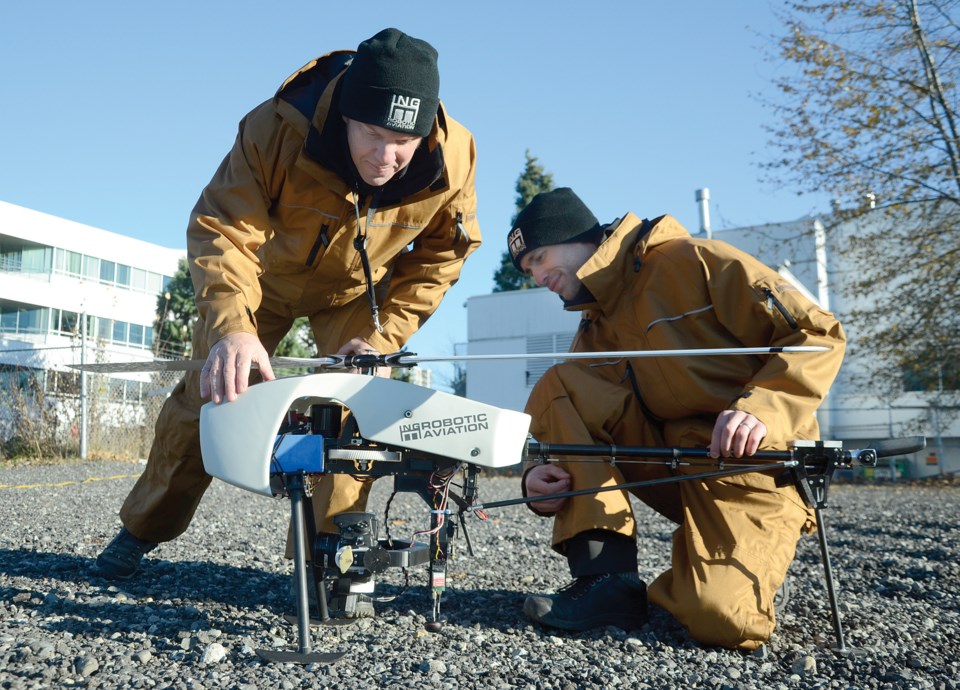A Canadian company is set to take robotic aviation by storm.
ING Robotic Aviation, an Ottawa-based company that builds and supplies unmanned aerial vehicles, or UAVs, is now turning its attention to the commercial market. The company debuted one of its aircraft at Mosquito Creek in North Vancouver last fall.
"We use our various platforms to provide services across the spectrum of industry, ranging from mining to forestry to oil and gas," said Luiz Araujo, director of regional business development at ING. "So the applications are actually numerous."
The company started about five years ago providing UAV operators to the Canadian military, clocking around 32,000 hours of flight experience in Afghanistan, said Araujo, and flying for the Canadian Navy more than two years ago in the Indian Ocean.
"Since technology now is migrating from purely a military environment and applications to civilian applications, the company now is also providing both services utilizing UAVs," said Araujo. "The spectrum of applications and the number of people and professions that will be able to benefit from this technology is amazing, and it covers the entire spectrum right from academia to police (and) public services."
ING has three different models of UAV aircraft: Responder, Serenity and the Huginn X1. Each aircraft provides video feedback and imaging to the operator.
"When you send a robotic aircraft in the air, the imagery is being transmitted in real time back to a ground control system and that information can also be shared through the Internet or sent to board rooms or sent to operation centres, so that situation awareness is quickly seen by a variety of folks," said Araujo. "That's something that is a great advantage of robotic aviation over traditional manned aircraft, this information relay in real time."
The Responder, used at Mosquito Creek, is a small electric-powered helicopter that has built-in infrared and can carry a variety of cameras, while the Serenity is a fixed-wing aircraft that runs on fuel. The Huginn X1 is a Danish product that ING resells and is used primarily in security or policing applications.
"These are new tools that are being introduced into the marketplace. If you think about a few years back when GPS first came out, it was purely a military application and then it just started coming out into use for cars," said Araujo. "Nowadays it's part of our everyday life and you have a GPS in your smartphone and everybody now relies on GPS as part of their everyday life. A number of applications with GPS now (are) also being used for commercial purposes."
ING hopes to corner the industrial and commercial markets, offering their services to everything from forestry and mining, to agriculture and real estate. Araujo said the aircraft could be used for such things as pipeline monitoring and forest fire management at a fraction of the cost of manned aircraft. The UAVs cost approximately $200 to $300 per hour to operate, including manpower and travel onsite, compared to what Araujo said a manned aircraft might cost at more than $1,000 per hour.
"That is a ballpark figure for operating a very complex system," said Araujo. "UAVs come out much, much cheaper, much more efficient than fixed-wing aircrafts and helicopters. There are applications where it is much more efficient to use robotic aviation than traditional aircraft."
Araujo said that although the public's privacy is a concern, the UAVs are like any other tool.
"People have binoculars, how do you stop someone from having binos and looking in somebody's window? How do you (stop) eavesdropping devices that you can buy in local security shops where you can actually listen to people's conversation? All those are concerns and UAV shouldn't be any more of a concern than all these other sensors that are readily available to the public," he said. "Professional use of these systems requires that you follow the law and we recognize the difference between flying and inspecting a building and flying and looking inside people's windows. That is always a concern but it's something that training and having the proper operators being certified to operate the aircrafts is probably the best way to ensure that privacy and proper use of this tool is followed."
Both the Responder and Huginn X1 are battery powered and have zero emissions. Araujo said the batteries take approximately 20 to 30 minutes to recharge, but with multiple aircraft and spare batteries, the UAVs could be kept in continual operation for 24 hours.
ING has already sold a few systems to international clients, said Araujo.
"This is the tip of the iceberg, we're just starting to see what are the possibilities," said Araujo. "As this technology is introduced for more commercial applications, you will see that they'll become more sophisticated. We'll be able to provide information, which before we never believed we would have access to."



